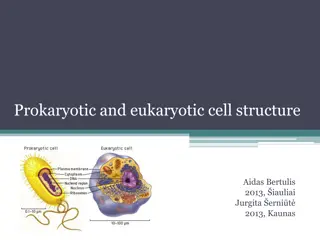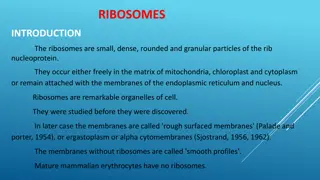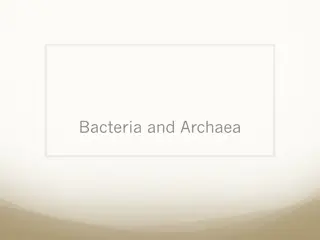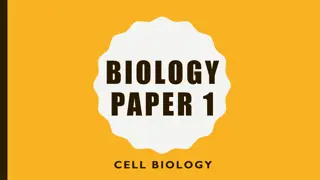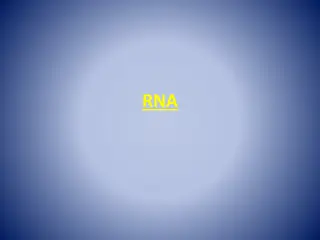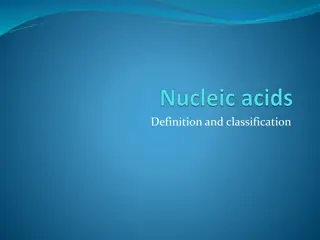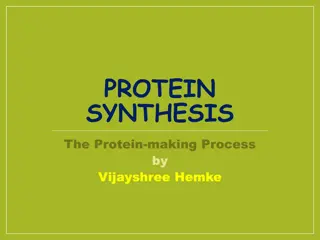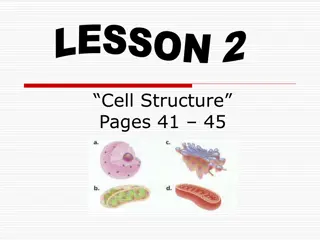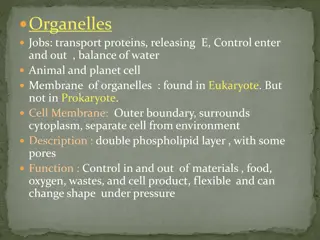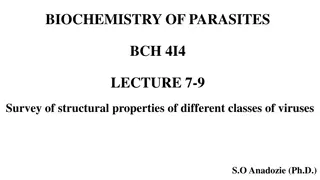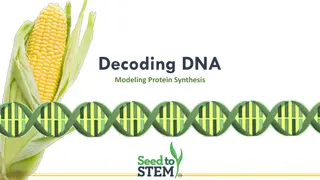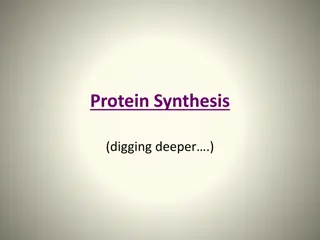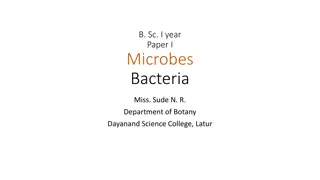Understanding Prokaryotic and Eukaryotic Cell Structure
This comprehensive guide explores the structures and characteristics of prokaryotic and eukaryotic cells. Learn about the differences and similarities between these cell types, including features like cell wall composition, membrane-bound organelles, nucleus presence, DNA structure, ribosomes, and m
7 views • 20 slides
Understanding Ribosomes: Structure and Function
Ribosomes, essential organelles in cells, exist in two types - 70s and 80s. They play a crucial role in protein synthesis. Structurally, ribosomes are composed of two subunits held together by Mg++ ions. The ultrastructure of ribosomes, particularly in prokaryotes, is intricate, with RNA and protein
0 views • 18 slides
Understanding Bacterial Cell Structure and Function
Bacteria display unique cellular structures and functions that differ from eukaryotic cells. They have a simple structure with a plasma membrane but lack complex internal membrane systems. The cytoplasm contains inclusion bodies, ribosomes, and genetic material in the nucleoid. Bacteria can be categ
4 views • 21 slides
Understanding Bacterial Form and Function: Structures, Shapes, and Arrangements
Explore the diverse structures common to bacterial cells, including membranes, ribosomes, and chromosomes. Learn about the shapes and arrangements of bacteria, such as cocci, bacilli, and spirilla. Discover external appendages that provide motility and aid in attachment and mating.
0 views • 85 slides
Exploring Cellular Structures in Quizbowl Biology
Biology in quizbowl competitions often focuses on understanding cellular structures, from organs to organelles. Players encounter questions about various organelles like mitochondria, ribosomes, chloroplasts, and the Golgi body. Ribosomes, though not classified as organelles, play a critical role in
0 views • 27 slides
Molecular Biology Concepts Overview
Explore key concepts in molecular biology including DNA replication, transcription, translation, and the central dogma. Understand the roles of DNA, RNA, ribosomes, and proteins in genetic processes. Visual aids and analogies help simplify complex processes such as the decoding of mRNA messages and
0 views • 19 slides
Cell Biology Overview and Organ Systems in Biology Paper 1
The Biology Paper 1 content covers topics such as cell specializations, cell division, organelles, enzyme functions, and organ systems including the cardiovascular system. It discusses key concepts like stem cells, mitosis, diffusion, osmosis, active transport, and various cell components such as nu
0 views • 8 slides
Understanding RNA and Protein Synthesis Processes
RNA plays a crucial role in protein synthesis as it carries coded instructions from DNA. There are three types of RNA - mRNA, rRNA, and tRNA, each serving specific functions in the process. The steps of protein synthesis involve transcription, where DNA is copied into mRNA, and translation, where mR
0 views • 11 slides
Understanding Nucleic Acids and RNA Molecules
Nucleic acids are linear polymers composed of nucleotides, with DNA and RNA being the main types. RNA consists of messenger RNA (mRNA), transfer RNA (tRNA), and ribosomal RNA (rRNA), each playing a crucial role in protein synthesis. mRNA carries genetic information from DNA to ribosomes, tRNA transf
0 views • 8 slides
Understanding Protein Synthesis Process
Explore the intricate process of protein synthesis, from transcription to translation, where genetic information is copied from DNA to RNA and decoded into proteins. Discover the essential role of ribosomes, amino acids, and enzymes in building proteins for various functions in living organisms.
0 views • 20 slides
Understanding Cell Structure: Key Organelles and Functions
Explore the intricate world of cell structure as we delve into the functions of essential organelles such as chloroplasts, mitochondria, ribosomes, endoplasmic reticulum, Golgi bodies, vacuoles, lysosomes, and the nucleus. Uncover the significance of each organelle in maintaining the cell's processe
0 views • 13 slides
Understanding Cell Organelles and Their Functions
Cell organelles play vital roles in the functioning of both animal and plant cells. From the cell membrane that controls the exchange of materials to the nucleus that governs cell activities, each organelle contributes uniquely. The cytoplasm provides a supportive environment for organelles, while t
0 views • 6 slides
Understanding Cell Structure and Function
Explore the intricate world of cell biology through this comprehensive guide covering the definition of a cell, the characteristics of animal cells, the role of the nucleus, ribosomes, cell structure, organelles, cell membrane, and cell wall. Discover the fascinating details of eukaryotic cells and
0 views • 61 slides
Understanding the Functions of Cell Organelles
Explore the vital functions of different cell organelles such as the cell membrane, nucleus, endoplasmic reticulum, lysosomes, Golgi apparatus, mitochondria, cytoplasm, ribosomes, vacuole, cell wall, chloroplasts, and chlorophyll in a cell. Learn how each organelle plays a unique role in maintaining
0 views • 38 slides
Survey of Structural Properties of Different Classes of Viruses
Viruses are small obligate intracellular parasites that require living hosts for multiplication. They lack ribosomes and metabolic enzymes, relying on host cells for replication. Viruses vary in size, shape, and genome organization, with classification based on morphology, physicochemical properties
0 views • 31 slides
Understanding DNA, Transcription, and Translation Process
DNA carries genetic instructions in organisms through nucleotide sequences like A, T, C, and G arranged in a double helix. Transcription converts DNA to mRNA in the nucleus, where RNA polymerase copies the DNA template. mRNA, with U instead of T, carries the genetic message. Translation involves ami
0 views • 26 slides
Understanding Protein Synthesis: The Molecular Machinery Behind Protein Production
Delve deep into the intricate process of protein synthesis, from transcription to translation, exploring the roles of DNA, mRNA, ribosomes, tRNA, and amino acids. Uncover the fascinating mechanisms that culminate in the creation of functional proteins, likened to baking a complex recipe. Discover th
0 views • 12 slides
Detailed Overview of Bacteria's Structure and Function
Explore the world of bacteria with a focus on their microscopic nature, general characteristics, ultrastructure of bacterial cells, and components like cell envelope, cytoplasm, and nuclear material. Uncover the diverse forms of bacteria, their mode of nutrition, reproduction methods, and unique fea
0 views • 12 slides
Exploring Animal Cell Organelles and Functions
Dive into the intricate world of animal cell organelles and their functions. From the plasma membrane to the nucleus, ribosomes, endoplasmic reticulum, Golgi apparatus, mitochondria, and more, uncover the essential components that drive cellular processes. Discover the roles these organelles play in
0 views • 7 slides
